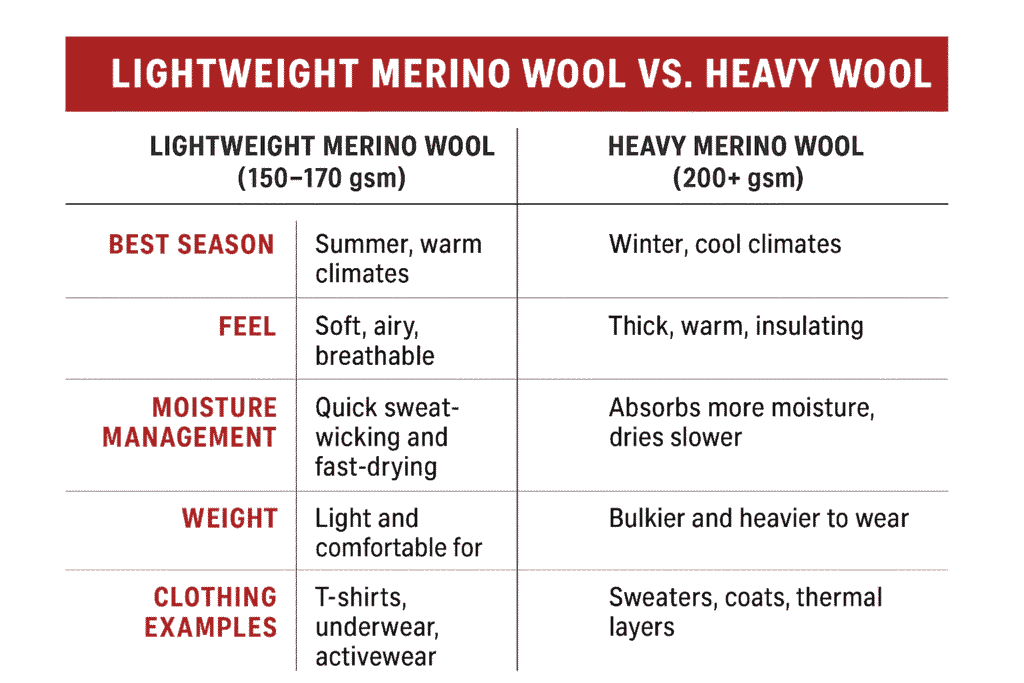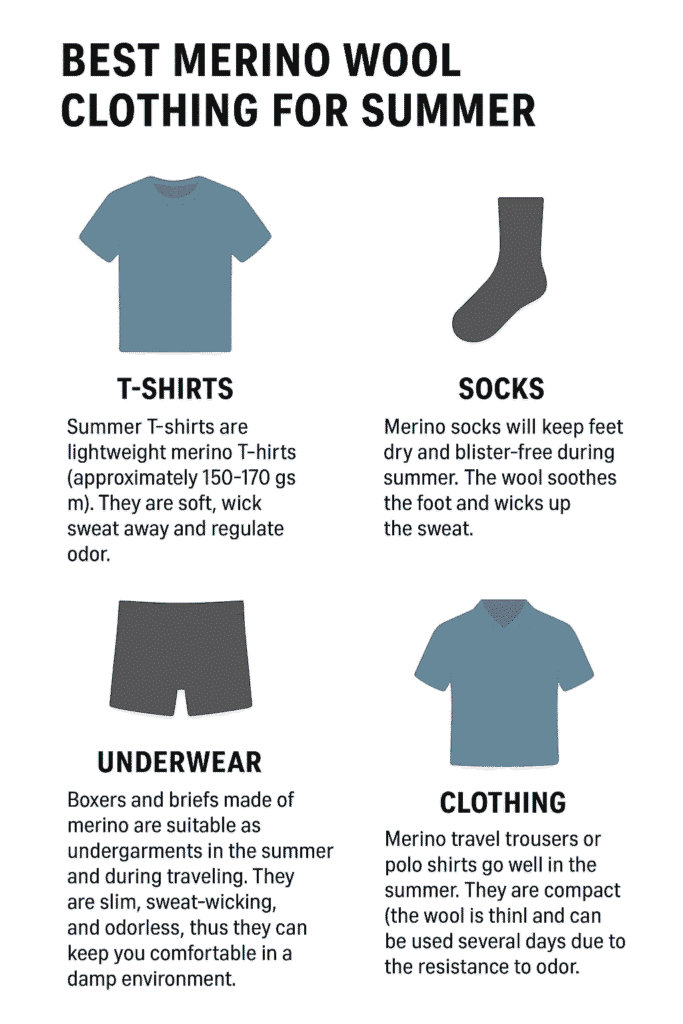What Is Merino Wool?
The Merino sheep produces ultra-soft and fine fibers that form Merino wool. The Merino wool is not very heavy like traditional wool, and it is smooth and light in nature, unlike traditional wool, which feels rough. This has rendered it appropriate not only in winter wear but also in summer wear.
The trick is the fiber structure. Merino fibers are thinner than regular wool and therefore they can bend easily without irritating the skin. They are also very effective in trapping air and can help in the regulation of temperature. These special qualities make Merino wool comfortable throughout the year, in hot climates as well.
The fact that it is soft and durable, and does not smell like ordinary wool makes it unique. That is why Merino has become popular among sportspersons, travelers, and other outdoor sportsmen and women, who require performance fabrics.
Is Merino Wool Good for Summer?
Yes, Merino wool is surprisingly a summer wool. Most individuals would think that wool should be used during winter only but Merino wool defies this myth. It is lightweight, breathable, and comfortable even when it is hot because of its fine fibers.
Its moisture management is one of its best advantages. Merino wool wicks evaporate off your body and dump it into the air, which keeps you dry. It does not stick to moisture the way cotton does, and it does not smell the way synthetics do.
Merino wool is cool and breezy in hot weather, so it can be used in t-shirts and underwear as well as socks and activewear. It keeps you cool, not hot, whether you are hiking, running, or just traveling.
Why Merino Wool Works Well in Warm Weather
Temperature Regulation
The Merino fibers contain air pockets that maintain the balance of body heat in various situations. During summer they emit extra heat and make you cooler. This is a natural control that makes it acceptable to be used outdoors as well as indoor.
Sweat-Wicking and Odor Resistance
The cloth snatches the sweat off the body and blows it in the air. This is what will keep you dry even when doing high-intensity exercises. Meanwhile, you can wear it longer without feeling uncomfortable due to its odor resistance.
UV Protection Benefits
Merino wool is naturally protective against the damaging UV rays. This allows it to be a great option when hiking, running or traveling during sunny seasons. It also covers your skin whilst being breathable, unlike the synthetic fabrics.
Lightweight Merino Wool vs. Heavy Wool

Old fashioned woolen clothes are thick and heavy and cannot be used in summer. On the contrary, lightweight Merino wool garments are worn in warm climates. Such fabrics are measured in gram per square meter (gsm).
In summer, the optimum weight of Merino wool fabric is 150-170 gsm. These lighter models are similar in feel to soft cotton t-shirts but work much better. Heavy Merino wool (200 gsm or greater), on the other hand, is generally worn during cooler weather.
The lightweight Merino wool also allows the highest number of breaths to travel through the garment without overheating. This is why it is worn on t-shirts, underclothing and in clothing that can be carried.
| Feature | Lightweight Merino Wool (150–170 gsm) | Heavy Merino Wool (200+ gsm) |
|---|---|---|
| Best Season | Summer, warm climates | Winter, cool climates |
| Feel | Soft, airy, breathable | Thick, warm, insulating |
| Moisture Management | Quick sweat-wicking and fast-drying | Absorbs more moisture, dries slower |
| Weight | Light and comfortable for travel | Bulkier and heavier to wear |
| Clothing Examples | T-shirts, underwear, activewear | Sweaters, coats, thermal layers |
| Comfort Level | Prevents overheating, stays fresh | Keeps body warm in cold |
Merino Wool vs. Cotton for Summer
Comfort
Cotton is soft and natural to the touch, and in summer it retains heat. When you start to sweat then it sticks and becomes heavy. Merino wool, however, remains dry and breathable and thus the level of comfort remains constant.
Sweat Absorption
Cotton takes in a lot of moisture and retains it hours, and that can be uncomfortable. When moist, it gets weighty and can lead to skin irritation. Merino wool helps in absorbing sweat and then gets rid of it in a few seconds so that you feel cooler.
Drying Time
Cotton garments take a long time to dry even after washing or sweating so that they cannot be used again. This precludes them in travel or adventure lives. Merino wool is quick to dry thus easy to wear on daily outings.
Pros and Cons of Each Fabric
Merino Wool Pros: Breathable, odor-resistant, quick-drying, lightweight, UV protection.
Merino Wool Cons: More costly, have to be washed tenderly.
Cotton Pros: Affordable, soft, widely available.
Cotton Cons: Retains sweat, slow drying, less durable for active use.
Merino Wool vs. Synthetic Fabrics for Hot Weather
Polyester
Polyester is widely used as a synthetic in summer activewear. It is highly durable and dries very fast, yet not as breathable as merino. Polyester has the bad habit of retaining smell and when you sweat, it is sticky even though it dries quicker. Polyester is not biodegradable like natural fibers because it is made of petroleum. A cheap shirt that will last long can be worn in hot weather but will hold sweat smell and introduce microplastic during the wash. In comparison, merino wool offers natural ventilation and odor protection, therefore, you remain fresher.
Nylon
The other synthetic that is used commonly in sports equipment is nylon. It is greasy, tough, and pours off. Nylon dries faster than cotton and a little bit slower than polyester. It is also strong and abrasive-resistant; however, like polyester, it does not breath or wick odors in the same way as merino. Nylon. It is clingy when wet and it sheds microplastic into the wash. When put next to the skin, nylon will feel warm in hot conditions. All in all, merino wool is more likely to stay cool and comfortable in warm humid conditions than nylon, despite the fact that both can deal with wet weather.
Bamboo
Fabrics made of bamboo (typically bamboo viscose/rayon) are marketed as environmentally friendly. The fibers of bamboo in themselves is renewable; however, the processing is carried out with a heavy use of chemicals. Bamboo rayon is made using toxic solvents nullifying most of its green advantages. Bamboo fabric may be soft and absorbent in performance, but it shrinks and wrinkles easily. It is also not as strong and breathable as merino, just like other rayon fabrics. It may also become faded and pilled away. A 100 percent bamboo rayon shirt will not absorb heat or smell as well as merino wool in hot weather. Merino is still the best in the heat and bamboo fabrics usually feel like heavy cotton without stretch.
Best Merino Wool Clothing for Summer

- T-Shirts: Summer T-shirts are lightweight merino T-shirts (approximately 150-170 gsm). They are soft, wick sweat away and regulate odor. Merino-specialty brands of T-shirts are intended to be worn in warm weather. Indicatively, merino crew-neck or V-neck T-shirts are the favorite clothing of many hikers because they breath easily and dry quickly.
- Socks: Merino socks will keep feet dry and blister-free during summer. The wool soothes the foot and wicks up the sweat. This eliminates wet, stinking feet when hiking or walking.
- Underwear: Boxers and briefs made of merino are suitable as undergarments in the summer and during traveling. They are slim, sweat-wicking, and odorless, thus they can keep you comfortable in a damp environment.
- Clothing: Merino travel trousers or polo shirts go well in the summer. They are compact (the wool is thin) and can be used several days due to the resistance to odor. Some people like one or two merino items to span various climates.
- Active Wear: Merino base layers and tops are great to use in the summer. They are natural breathers and UV protectors. Merino shirts are commonly used by runners and cyclists to cool and keep odor at bay.
Practical Uses of Merino wool for Summer:
Merino wool can be used practically outside. It is the perfect choice when going on hikes and camping since it tries to adapt to the weather changes. A long sleeve or T-shirt made of merino will keep the cold of an early morning and the heat of the midday without a change of clothes. It works great to run or bike in, the cloth will not get wet, it will not chafe, and it has low odor. In the summer evenings, merino polo shirts or sweaters are smart looking and comfortable on the skin. And to travel, merino can be packed away and smells nothing, so that you can pack fewer clothing. In all these activities, the fabric’s breathability, softness, and odor-fighting ability shine.
Common Misconceptions About Wearing Wool in Summer
- It is widely believed that all wool is warm, dense and uncomfortable during hot seasons.
- Merino wool is not like this, as it is light, soft, and breathable.
- The fine fibers ensure that the body temperature is maintained naturally by shedding off extra heat.
- Merino wool keeps a person dry and removes the sticky sweat.
- The fibers allow the air to circulate inside the body and keep it cool even in direct sunlight.
- Merino is comfortable to wear in summer and winter as opposed to regular wool.
Care Tips for Summer Merino Wool Clothing
- Light Washing: Wash in a gentle cycle in cold or lukewarm water with a mild detergent. Use no bleach or fabric softeners, which will destroy the fibers. Machine wash merino items inside out for extra protection.
- Drying: Merino clothes can be dried by air, preferably flat. The wool dries quickly on its own. When you have a dryer, you should use a low or wool setting. This stops the shrinkage and maintains the fabric integrity.
- Do NOT Handle Roughly: To prevent the stretching of merino, it should not be stored hanging, but folded up (especially heavy knits). To remove any pilling, use fingers to ease the loose fibers.
- Odor Control: Make use of the natural odor resistance of merino. You do not always have to wash merino clothes after each use. They normally just need to be aired out. When you finally wash, the cloth remains clean since the bacteria do not cling on.
- Sun Care: Despite the UV protection of merino, it is still a good idea to wash and re-apply sunscreen to keep both the fabric and skin in excellent condition.
Sustainability and Eco-Friendliness
Merino wool is a natural, renewable and biodegradable substance. It does not emit plastics that are harmful to the environment (synthetics do). Merino sheep produce a new fleece every year, which makes it a sustainable variant.
Also, the durability and odor resistance of Merino clothing can last longer, making it necessary to change clothes regularly. This has made it eco friendly and financially viable in the long term. You will be making a sustainable purchase by wearing Merino.
Conclusion-
And thus, is merino a summer wool? The answer is a clear yes. The fact it is lightweight, breathable and wicks away sweat makes it one of the best fabrics to wear during warm weather. Merino wool keeps you cool and fresh throughout the day unlike cotton, which traps moisture and synthetics, which traps odor.
It fits every kind of summer activity: from mountain paths to urban streets. Its natural UV blockage is another added advantage and makes it safe when going out. Further, Merino wool is renewable, biodegradable and sustainable which mitigates its negative impact on the environment.
When you invest in Merino you are investing in both comfort and quality that lasts. It can be worn in the fall, the winter, the spring, and all around, so wool is not only winter.
Learn More>> In detail about Merino wool.
FAQs
Yes. The fine fibres of merino wool permit circulation of air. This breathability, coupled with an ability to keep your skin dry and cool, even though it is hot, with built-in moisture-wicking.
It does. Merino wool also controls temperatures by drawing moisture out of your body and letting the extra heat escape. It is cooler and drier in hot weather than heavy wool, which retains heat.
Absolutely. Merino wool is a good fabric in humidity as it actively moves moisture off. A lightweight merino shirt will be drier and more comfortable than either cotton or polyester in sticky conditions.
Not if it’s true merino wool. Merino of high quality is not scratchy. It is smoother than the thick wool or most synthetic materials. The majority of individuals consider summer-weight merino to be quite comfortable when compared to bare skin.
Merino is usually better than cotton when subjected to heat. The merino repels sweat and absorbs quicker than cotton. It also regulates odor itself, as opposed to cotton, which retains moisture and smells. Although cotton can be cold at first, merino has a more consistent body temperature because it moves the moisture away and allows it to evaporate.
